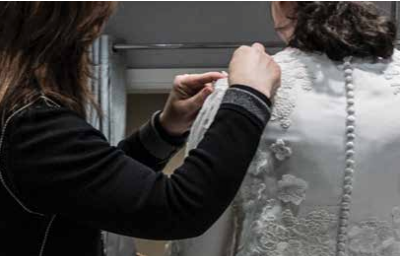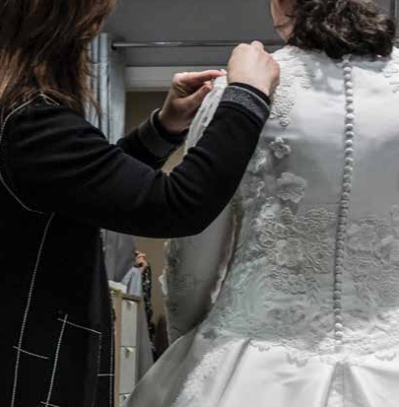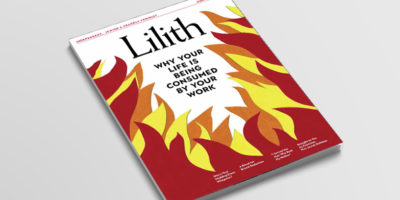
The Wedding Dress Whisperer and Me
 As a newspaper reporter, I have spent my life speaking to successful people who make and shake in many fields. But one of the most charismatic of these was in one of the least likely places: a small mirror-lined dressing room tucked into the back of Kleinfeld Bridal on West 20th Street in Manhattan, the bastion of the latest in wedding-dress fashion.
As a newspaper reporter, I have spent my life speaking to successful people who make and shake in many fields. But one of the most charismatic of these was in one of the least likely places: a small mirror-lined dressing room tucked into the back of Kleinfeld Bridal on West 20th Street in Manhattan, the bastion of the latest in wedding-dress fashion.
There, behind the main salon and all its hullaballoo (where, by the way, women of all shapes and sizes try on sheer-bodice, half-nude strapless bridal gowns) one finds Rochel Leah Katz, a petite 51-year-old woman who is always stylishly dressed (albeit in a below- the-knee skirt with dark stockings and a long-sleeved top), nicely coifed (although wearing a sheitel), and tastefully bejeweled.
There, she quietly conducts her business in the cozy, slightly crowded dressing room that doubles as her office.
Rochel Leah [pronounced Ruh-khl Lay-uh], as she’s known to her clients, is the one sales consultant in this world-famous bridal store assigned to sell “modest” dresses to brides-to-be from ultra-Orthodox communities—Hasidic and others. (She also works her magic with Modern Orthodox brides-to-be who come to her from near and far and whose sleeves can be a few inches shorter and necklines a bit lower than on the styles of the more traditionally attired. There are different requirements for different rabbis, she told me.)
Rochel Leah came to work at Kleinfeld 17 years ago to build a niche business selling bridal dresses to frum women. This past year she sold over a million dollars in dresses, according to Ronnie Rothstein, a Kleinfeld Bridal owner.
Rochel Leah attributes her business success to her ability to establish trust with the customers. She comes across as the caring balabusta she is, spending as much time as the “girl” needs to choose a dress, and then for the dress to be custom-fitted perfectly. She’s truthful and frank, well-schooled in the laws and customs of ultra-Orthodox wedding garb, yet amazingly sophisticated about fashion, adjusting a puff sleeve by just an eighth of an inch, for example, thus changing the shoulder to flatter a bride’s upper-arm contours.
I actually met her by accident when I was at Kleinfeld reporting a story for The New York Times about Randy Fenoli, a star of the cable television show “Say Yes to the Dress.” The show is taped in Kleinfeld’s main salon, a few feet from Rochel Leah’s room, but because she adheres to a strictly Orthodox way of life, and does not watch television at home, she sees the program only when the television is on at Kleinfeld.
 Although for every one of her frum clients the bodice of the gown must be high enough to cover the collarbone, and the sleeves have to stop below the bride’s elbows, according to a strict interpretation of Jewish law, nobody feels dowdy in Rochel Leah’s dressing room. She doesn’t permit any woman to feel unstylish or frumpy.
Although for every one of her frum clients the bodice of the gown must be high enough to cover the collarbone, and the sleeves have to stop below the bride’s elbows, according to a strict interpretation of Jewish law, nobody feels dowdy in Rochel Leah’s dressing room. She doesn’t permit any woman to feel unstylish or frumpy.
Fascinating—at least to me—is the fact that while the completed bridal gowns must be high-necked and long-sleeved, these brides-to-be all start by trying on a strapless dress—“in order to feel sexy,” according to Rochel Leah— although they wear a long-sleeved white jersey underneath when trying it on in order not to reveal any skin, even in the privacy of a dressing room!
“None of my customers want to try on a ‘built up’ gown to begin with,” she said. “I’ve tried. They won’t buy.” So she helps them imagine what the finished dress will look like by holding extra fabric above the neckline of the strapless gown and by mocking-up “sleeves,” often of lace, on the arms.
She describes the fabrics her designers use: “tulle, organza, gazar….” And as for the lace and embellishments, those too come in many guises, from “Chantilly to re-embroidered Alençon.”
Every client is given her undivided attention and made to feel special. “My mission is to make every woman, young or older, feel that she looks beautiful. It’s a mitzvah,” she said.
Rochel Leah is a woman who not only knows the laws and customs of the Orthodox community she works with, but strictly adheres to them herself. When I asked if she has ever been tempted to cheat—to eat non-kosher food, for example, or to wear shorter sleeves—she emphatically answered, without missing a beat, “Never!” She refers to herself as pious and “Litvish”—meaning from the intellectual traditions of Lithuania, not the more spiritual Hassidic strain of ultra-Orthodoxy from Poland.
She lives in the middle-class Midwood section of Brooklyn with her husband of 32 years and their youngest, yet-to-be married son, who is 20. Her other five children, three boys and two girls, are all married, have their own children (there are now 12 grandchildren), and live in religiously observant communities near New York City.
It turns out that only a few designers will work with Rochel Leah and her clientele, because these dresses must be custom-made to fit not only the bride but also the religious requirements, and they must be made quickly.
 Her two main designers are Tony Ward, who lives and works in Beirut, Lebanon, and Edgardo Bonilla, a Puerto Rico-born man who lives in New Jersey and maintains a small workroom there. Both men are able to produce their dresses in a timely fashion; they know the usual engagement period for an ultra-Orthodox couple is short.
Her two main designers are Tony Ward, who lives and works in Beirut, Lebanon, and Edgardo Bonilla, a Puerto Rico-born man who lives in New Jersey and maintains a small workroom there. Both men are able to produce their dresses in a timely fashion; they know the usual engagement period for an ultra-Orthodox couple is short.
A betrothed couple has typically had only a few brief “dates”—perhaps in a park, at a mall, or in someone’s home. Often they are younger than 20 when they get engaged. The very Orthodox couples are always introduced to and carefully chosen for each other by their parents, and they are married within a few months of the engagement. (Thus the rush on producing the gowns.) The Modern Orthodox may arrange their own marriages, but they still need the dresses to be made as per the religious requirements.
Do these arranged marriages last, I ask? Even though there is divorce among the Orthodox, Rochel Leah thinks it is less common than elsewhere, because “all our religious laws are to enhance the relationship.” (Others I spoke to disagree, and say the divorce rate is spiraling among the ultra-Orthodox.)
Because most of the brides-to-be are very young, they come to Kleinfeld with their mothers, who usually make the final decision about the dress. Some of the mothers themselves are so young they arrive pregnant, perhaps with a parade of pre-school-age offspring in tow. Rochel Leah told me that her own mother was pregnant when she walked her down the aisle; “my youngest sister is only five months older than my oldest child,” she said. “My mother and I nursed together for awhile.”
After the initial visit, or the second, third or fourth trip to the store, after the bride-to-be chooses a design, the strapless dress will be “built up,” or actually redesigned to have the requisite high neck, long sleeves (lined, if they are lace, so no skin shows), and an opaque bodice atop a full ball-gown skirt. “They all want big skirts,” Mrs. Katz says. “They like a ball gown because it makes them feel most ‘bridal’. It gives them a fairytale look.” We don’t discuss the obvious paradox: that real-life marriage is no fairytale.
Rochel Leah is off on Friday afternoons and Saturdays for Shabbes, but other than those times she is available for appointments whenever the store is open; all sales are by appointment only. In her precious little “spare time,” she maintains a side business coaching young women about to be married. She is not a religiously certified kallah (bride) teacher who instructs girls in the laws of marriage, kashrus and rituals, but rather works on subjects like relationship formation, how to navigate through the trials and tribulations of a new family, and how to handle the first disagreement after the wedding. “These girls are so inexperienced they sometimes feel if they have an argument with their new husband the marriage is over,” she said. “I have to teach them how to communicate and negotiate.”
She says she teaches “social skills” to young woman who have no experience with young men. “They have never even been in school together, so there is no awareness of gender differences and how to speak to each other.”
“Coaching deals with the practical side of marriage,” Rochel Leah explained. “Expectations, going into a new family, how to criticize and take criticism.”
She teaches one-on-one and charges $300 for a series of three classes. “We usually meet for an hour and 15 minutes, but the time depends on how open and schmoozy the girl is,” she said. “They have to share experiences with me. They have to say how they grew up and what lingo was used in their house. Some parents are very open with their children, some are not. I teach the dynamics of living with a man.”
Her brides-to-be are encouraged to phone her even after the classes are over if they have questions, or if issues arise in the marriage.
Being curious (after all, I am a reporter), and rather unknowing about Orthodoxy, I found her niche interesting and came back to Kleinfeld to spend time chatting with her to learn more.
But a little chat about wedding gowns turned into a full discussion, and we covered much more ground than just wedding attire. I found myself drawn back time and again to talk to her in her small makeshift “office.”
I being secular, she being—as she put it—“pious,” I initially assumed we would have no connection at all. Also, I had had little contact with ultra-Orthodox women, and I realize now it was I who at first approached our meetings with some bias, certainly with a lack of knowledge. Because of this I thought it would be difficult for us to relate to one another. I also assumed, wrongly, that Rochel Leah Katz would, at the very least, wish that I shared her beliefs and customs. It turned out that she was anxious lest I find her “narrow-minded” and “old fashioned.”
But then, when our conversation went from wedding dresses to cooking—and much to my surprise when Rochel Leah spoke of baking rugelach and hamantaschen—I found myself unwittingly revisiting in my mind the scent of my grandmother’s Brooklyn kitchen and the sight of her hands working the dough, configuring various shapes of cookies and cakes for Shabbes or holidays.
I left that meeting feeling amazingly close to this woman in a way that caught me off guard.
Speaking to Rochel Leah that day brought back to me thoughts of my grandmother, also an independent working woman who lived in East Flatbush, Brooklyn, and with whom I spent many weekends during my early childhood. The indelible impression she made on me had so much to do with the food she cooked and baked. To this day I use her recipes for holiday meals with my own children and grandchildren. And I make an effort to pass these on to them since for me, in my secular way, this is our religion—our family tradition. After all, what is more delicious and religious than a tasty, fluffy matzoh ball and some not-too-salty chicken soup?
By now, after a few meetings with Rochel Leah, I was drawn in not only to discussions about food and holidays, but was also interested in her retail business and wondering how she dealt with her customers, most of whom, by the way, were not too happy having me insinuate myself into their shopping experiences—certainly not inviting me into their dressing rooms to critique the gowns with them.
But I could see, even from afar, Rochel Leah’s business acumen, and her way of selecting and then selling just the right garment for each customer. Her manner was gentle yet strong. There was no hard sell here, but her confidence led the way to success.
I returned again. And when I came for our next wedding-gown discussion, Rochel Leah presented me with a mini challah she had baked the night before.
That little loaf tugged at my emotions. Again, I was filled with memories of my grandmother making challahs and giving me little pieces of dough to braid for my own small loaves. How strange, I thought. Could food become the cord that binds people together? Or at least connect two professional women—from completely different religious communities—working hard to be successful in their own right?
I wondered if it was only food, or do we also share some cultural DNA? Even though in my world a strapless wedding gown is acceptable for some brides, even if not appropriate for others. (My own daughter was married under a chuppah in a strapless gown but wore a long-sleeve jacket over the bustier during the ceremony.)
It was a Thursday, and Rochel Leah said she had already baked bread and cooked food for that week’s Shabbes meal, when she expected dozens of people around her dining table—children and grandchildren, perhaps even some in-laws.
Now I felt not only connected but also a bit envious of her having the warmth and good feelings of multi-generations sitting in what we, decades ago in Brooklyn, called the “dinette,” but which she now calls the dining room (she having moved up to a private home, as opposed to the four-family apartment house my grandparents rented in), enjoying each other and the family meal each week. For Rochel Leah it’s Shabbes; for me it was a childhood of Sunday lunches—and all the discussions and arguments the adults had—in my grandparents’ place.
At that point the connection for me had nothing to do with religious beliefs; we shared a unique heritage that felt stronger than any Torah portion could.
Marianne Rohrlich is a journalist in New York who specializes in home design and wedding style columns, as well as feature stories in those areas. The Personal Shopper column appeared in the Home Section of The New York Times; Registry and Field Notes are in The New York Times, Sunday Styles.


